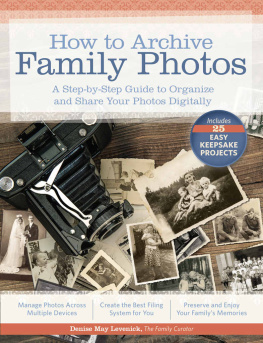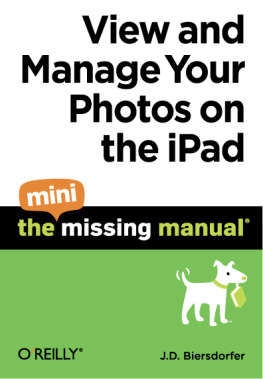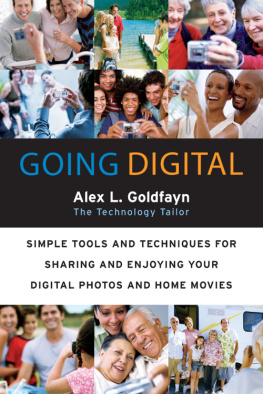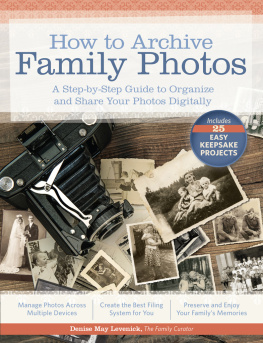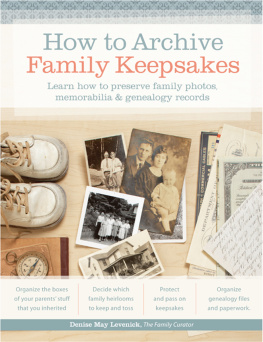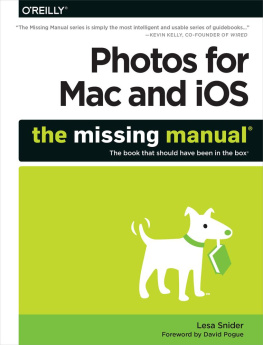How to Archive
Family Photos
A Step-by-Step Guide to Organize and Share Your Photos Digitally
Denise May Levenick
The Family Curator
Cincinnati, Ohio
shopfamilytree.com
DEDICATION
To my memory-making family: Dan, Zack, and Christian
Contents
Discover the essential tools and skills for working with digital images. Use the Digital Photo & Video Storage Worksheet and Getting Started Checklist to prepare for organizing your photo collection.
Unsure what to do with all the images on your various digital devices? This chapter focuses on how you can transfer images to a central digital library using an easy-to-remember routine.
Photo-editing and photo-management software can help you automate your digital photo-organization routines. Learn about the software options available and key features to consider to help you manage your digital photo collection.
Photo websites for photo sharing, publishing, creating gifts, and storing a backup of your digital image files are abundant. This chapter will introduce you to some of the best photo websites and provide you with a Cloud Storage Service Comparison Worksheet to evaluate your online photo-storage options.
Put all the organization advice and information together. This chapter presents step-by-step workflows you can use to establish a digital photo-organizing routine.
Remember the days of 35mm film and double prints? Inherit a collection of 1900s ancestor photos? Digitizing those old family photographs is a great way to preserve them for future generations. Learn tips and use the Heirloom Photo Inventory & Digitizing Checklist for deciding which images to digitize.
Digitizing photo collections takes time. This chapter guides you through creating a plan, setting up your computer, and choosing digital storage equipment to efficiently digitize and organize your photos.
A scanner is a key piece of equipment for digitizing old family photos. This chapter introduces you to types of scanners and key features to consider when deciding how to digitize your images.
This chapter provides step-by-step guidance to begin digitizing your photos, from heirloom photos to multi-photo album pages to negatives and slides. Use the Heirloom Photo Scanning Checklist to help you establish a scanning workflow plan.
What do you do with your photos once youre done scanning them? This chapter provides basic advice on how best to preserve and store hard-copy photo collections.
Learn the basic skills and terminology youll need to know to complete a variety of photo projects.
P ROJECTS : A thank-you card, a mouse pad collage, a holiday greeting card collage, an ancestor collage, a custom Facebook cover photo, and a digital scrapbook tribute page.
P ROJECTS : A wall calendar, a perpetual celebration calendar, plus ideas for celebration, year-in-the-life, and family foodie calendars.
P ROJECTS : Mobile apps to label a photo, enhance tombstone photos, create a photo book, develop a family history timeline, and create an audio photo book.
P ROJECTS : A vintage holiday photo pillow and photo quilt block.
P ROJECTS : A custom photo book, an autofill birthday book, a family yearbook, an heirloom reproduction book, a photo book for busy people, a grandparent and grandchild memory book, and a remembrance and celebration book.
Introduction
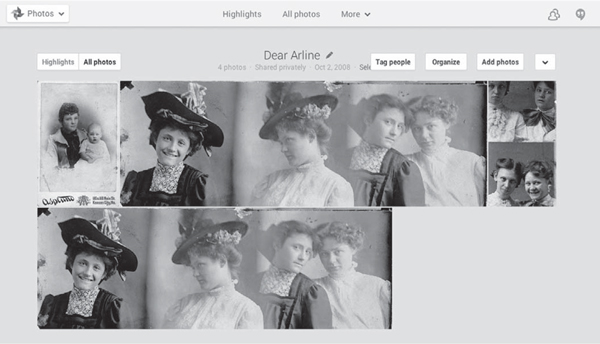
The computer hard drive has become the photo shoebox of the twenty-first century. We toss digital files into our computers (or smartphone memory) much like our parents tossed snapshots into cardboard shoeboxes. Our computer and mobile devices are soon cluttered with the digital folder equivalent of old photo-processing envelopes labeled with scrawled memos like Dads 80th Birthday or Hawaii Vacation. Sometimes the photos make their way into albums and scrapbooks, but too often the digital shoeboxeslike their cardboard cousinsfill with more photos and are stashed away to be organized one day.
I was fortunate to inherit dozens of boxes of old family photos collected by several generations on both sides of my family tree. Although only a handful of tintypes and daguerreotypes survived, each successive generation added new photos snapped with the technology of their time to create a family photo timeline that followed the growth and popularity of personal photography, from cartes de visite and cabinet cards to Brownie snapshots, Polaroid prints, Kodachrome slides, and home movies.
By the time my grandmother was a young woman in 1905, she was already snapping photos with a Brownie box camera and pasting prints on black album pages. Shoeboxes bulging with black-and-white prints and negatives bear witness to her fascination with photography. My mom and aunt followed Grandmas lead with their own photos, filling more shoeboxes with a jumble of albums, slides, movies, and loose prints that I inherited when they passed away. Now Im looking at my own life in fading Fujicolor and realizing that printed images are only a hint of the digital deluge headed our way. More than 880 billion photos were snapped in 2014, according to Yahoo!, most of them digital pictures taken by smartphone cameras. My grandmother would have loved it!
Coincidentally, the same year I inherited my grandmothers trunk filled with family treasures, I also brought home my first digital cameraa little Nikon Coolpix that snapped 1.9 megapixel images visible almost instantly on the cameras tiny image viewer. As a genealogist and the designated keeper of the stuff for my familys heirloom photos and documents, my digital shoeboxes were already bursting with scanned images. It didnt take thousands of new photos for me to realize that I needed a simple yet comprehensive image management system to keep up with new digital snapshots and scanned images of my family photo collection.
In my book How to Archive Family Keepsakes, I shared my system for preserving and organizing all kinds of inherited family treasures, and basic steps for digitizing heirloom photos and documents. But as I wrote those chapters, I knew that scanning old photos was only part of the problem facing todays family historians. Its a golden era for genealogy that allows us to
- access original records through digitized editions available online.
- preserve one-of-a-kind photos and documents by scanning heirlooms with affordable home equipment.
- share stories, pedigrees, and research through e-mail and websites.
- create our own digital legacy with new digital photos, videos, and audio.
But all of these digital files are meaningless without a way to tap into the stories they hold and share those stories with others. How many photos are somewhere in your digital library, waiting until you can find them again? How many digital shoeboxes filled with family snapshots do you have stashed on your smartphone, tablet, e-reader, and computer waiting to be organized and enjoyed? Isnt it time to get those images out of the digital shoebox and into your hands to be enjoyed and shared with family and friends?
HOW TO USE THIS BOOK
This book shares practical strategies for conquering digital image clutter and confusion so you can enjoy, preserve, and share your family photos and stories. In the same way that genealogists start with the present generation and work backward one branch of the family tree at a time, this book begins with the present to help you master your current digital clutter before you tackle the previous generations of photographs.

